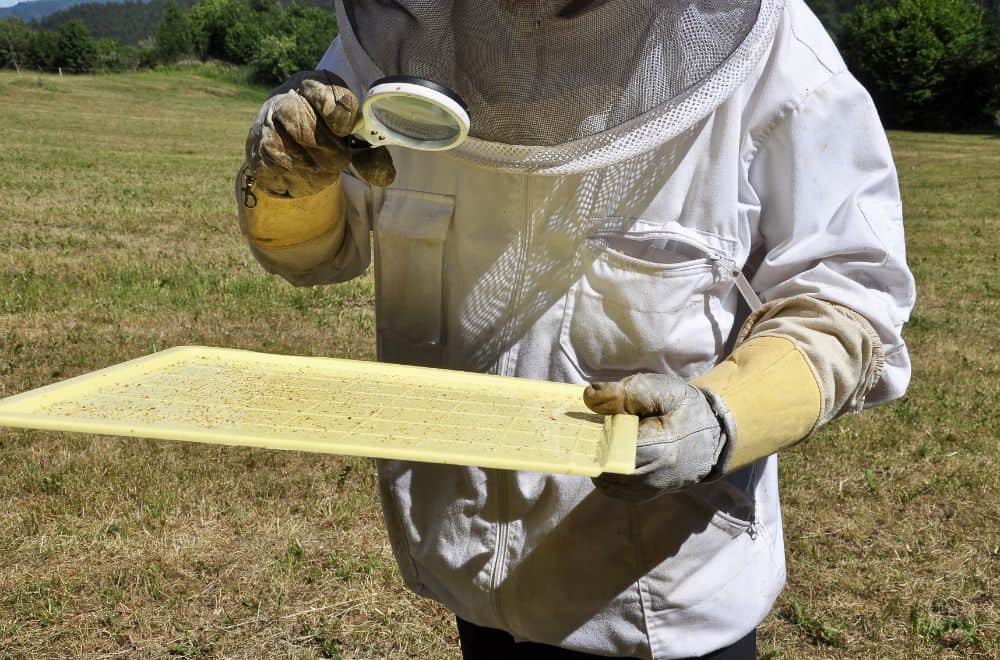Most people have had experience with insects living in groceries at some point. One of the most significant challenges regarding kitchen pests is definitely little bugs in the flour. You can often find them in kitchen cupboards and pantries, where they attack other dry food besides flour, like rice and cereals.
Sometimes is impossible to avoid these pests’ infestation because flour can be contaminated in the mill or during transportation. For instance, it is practically impossible to detect eggs after females lay them in flour and packaging because of their small size.
Little bug in the flour |
||
| Type | Length | Color |
| Khapra beetles | 0.07 to 0.15 inches
(1.8 – 3.8 mm) |
Reddish brown or brown to black |
| Flour mites | Males – 0.013 to 0.017 inches
(0.3 – 0.4 mm) Females – 0.014 to 0.026 inches (0.35 – 0.7 mm) |
Pearly or gray-white |
| Flour weevils | 0.12 to 0.16 inches
(3 – 4 mm) |
Red-brown |
| Confused flour beetle | 0.12 to 0.16 inches
(3 – 4 mm) |
Red-brown |
| Red flour beetle | 0.09 to 0.17 inches
(2.3 – 4.4 mm) |
Red-brown |
| Indian meal moths | 0.12 to 0.18 inches
(3 – 4.5 mm) |
Purple-brown with pale yellow lower body and greyish-white wings |
Little Bugs in the Flour
Flour bugs are tiny pests that feed on dry food in the pantry. They prefer flour and cereals but can also feed on rice, dry fruits, spices, pasta, and cake mixes. Some pest control experts claim these bugs never attack whole wheat flour.
Even though numerous bugs can attack your flour, the most common types include the following:
1. Flour mites
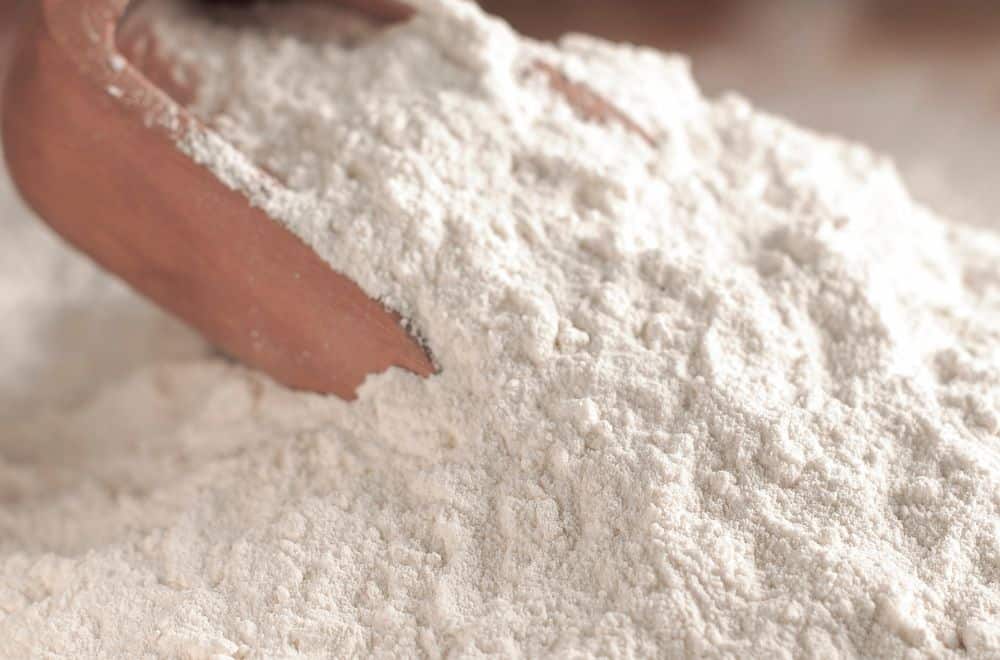
It is unlikely to spot these bugs because of their microscopic size, making them invisible to the naked eye. Males are 0.013 to 0.017 inches (0.3 – 0.4 mm) long, while females are a bit longer, 0.014 to 0.026 inches (0.35 – 0.7 mm).
Flour mites are pale, pearly, or gray-white insects that remind white fibers with pale yellow to red-brown legs. They primarily attack flour and cereals in the pantry and grain warehouses when humidity is too high.
You can be sure your flour is contaminated when noticing a brownish layer on the flour smelling like mint. Additionally, food made from mite-infested flour will taste sweet. Unfortunately, these mold-type mites can jeopardize your health by causing allergic reactions.
2. Khapra beetles
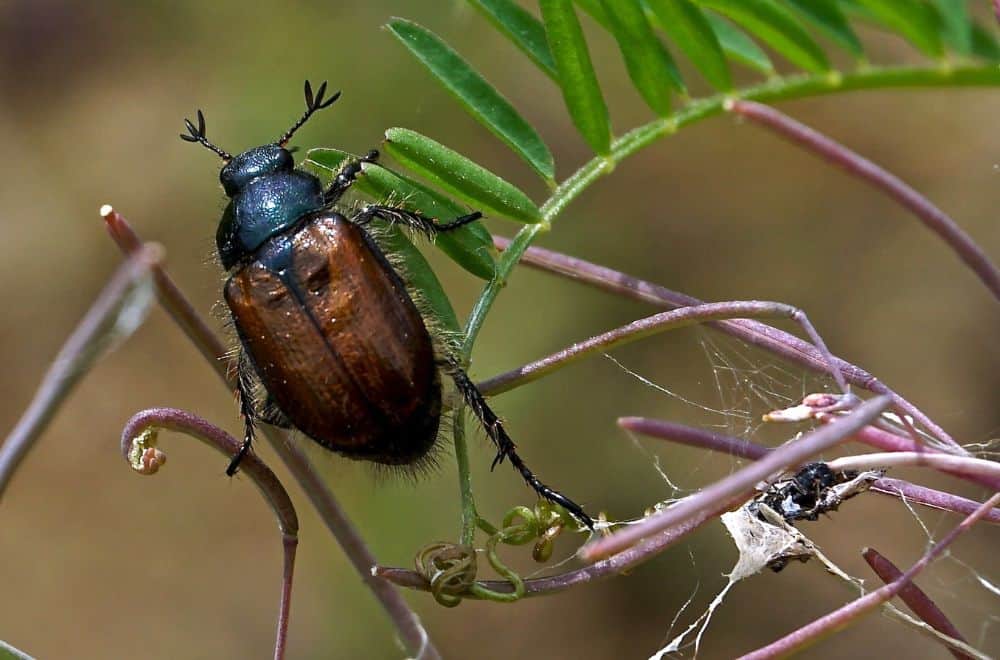
Khapra beetles are widespread pests you can find throughout the US. These voracious, 0.07 to 0.15 inches (1.8 – 3.8 mm) long bugs are among the worst existing invasive pest species you can find in your pantry. They feed on flour, primarily barley flour.
You can recognize these flying insects for their reddish-brown or brown-to-black bodies. However, they rarely use their wings but prefer crawling in packages and nibbling flour and little grain parts.
They can survive freezing temperatures and those up to 140 F (60 C). So, you can’t eliminate them like others by putting the flour bag in the freezer. They live only 5 to 10 days but leave their eggs and larvae to destroy your food.
3. Flour weevils
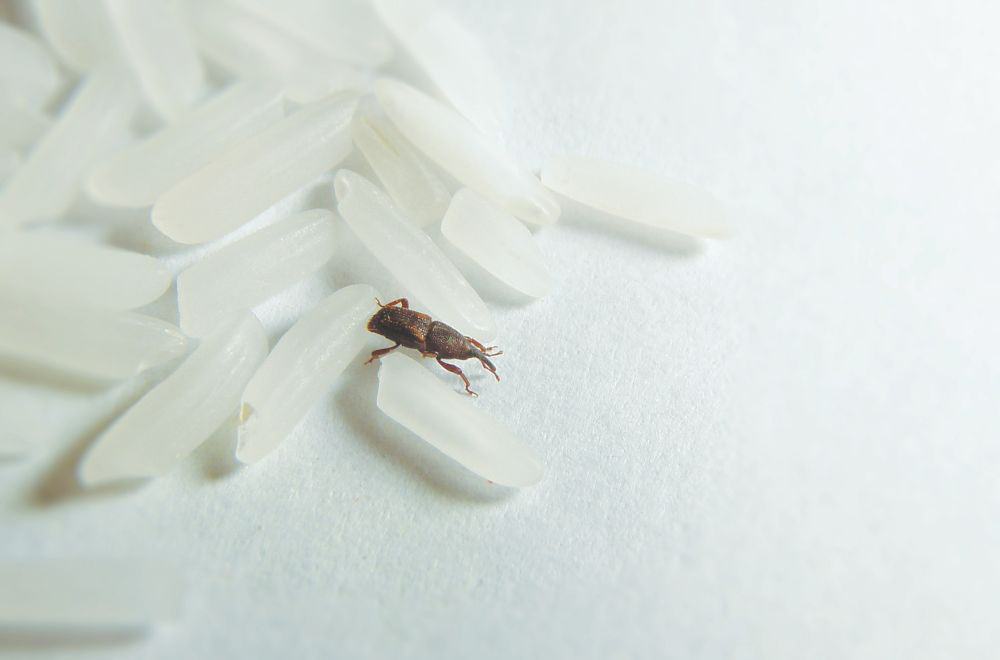
Flour weevils are 0.12 to 0.16 inches (3 – 4 mm) long black-red or metallic reddish-brown bugs with six legs and a characteristic snout or beak on their mouth. They typically attack all flour types, including corn and wheat.
You can expect them to enter your pantry in two ways, by flying or on the packaging. Since adult bugs chew on cardboard, paper, or plastic bags, females can effortlessly pass and lay eggs inside.
The occurrence of tiny whitish worms in the flour is a sure indicator of larvae infestation. They feed on flour and defecate inside it, so it is necessary to discard it when noticing visible fecal balls and tiny clumps. Otherwise, you can face invasion when adults develop about ten days later.
4. Confused flour beetle
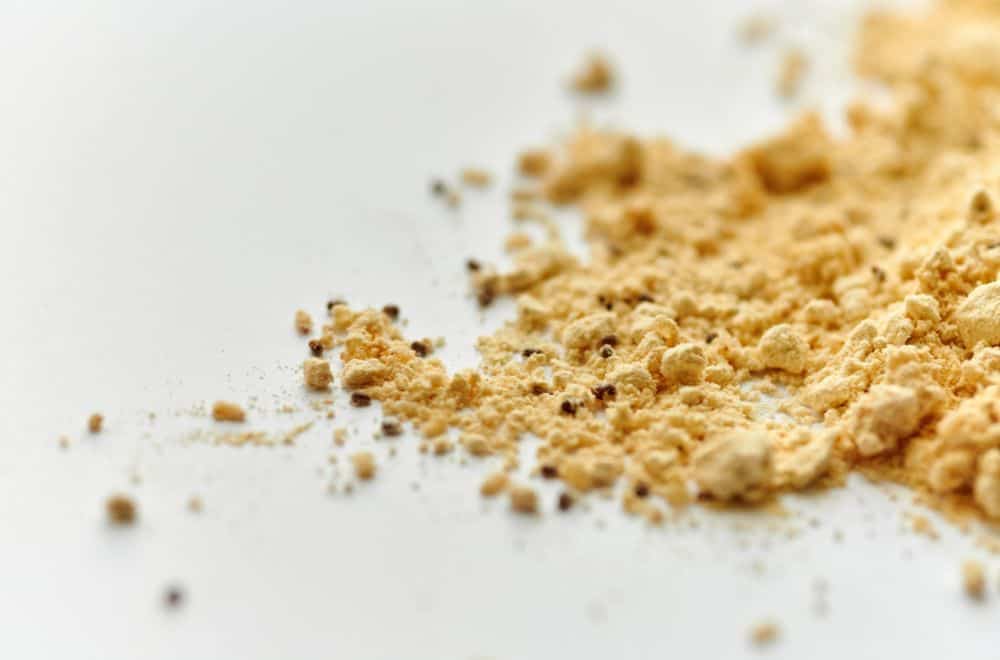
Confused flour bugs are red-brown, 0.12 to 0.16 inches (3 – 4 mm) long pests with a pair of antennae on its head. They can’t fly and end up in your pantry only when you bring them in with other groceries.
These bugs attack cereals and flour and are capable of chewing cardboard boxes and plastic and paper bags. After reaching the pack of flour, they start feeding on it and lay eggs inside. Unfortunately, eggs are microscopic, and it is impossible to notice them. The only sign of their presence is small lumps of flour.
Once hatched, cream-yellow or pale-brown larvae continue to feed on flour. The next stage lasting 40 to 90 days, is the cocoon. Once beetle adults emerge from cocoons, they start mating and continue doing that throughout the year.
Since their lifespan is approximately three years, these bugs can become a severe danger to your pantry when you fail to remove them. Although they neither bite nor transmit infectious diseases, they may cause allergic reactions in sensitive people.
5. Red flour beetle

Red flour beetles are similar to Confused flour beetles, but you can notice some differences. They are 0.09 to 0.17 inches (2.3 – 4.4 mm) long flying bugs with red-brown bodies. Their lifespan is about three years, and they prefer spending that time in warm regions, particularly the southern US.
Each female lays approximately 200 to 450 eggs in food during their lifespan, significantly increasing infestation in the pantry. The result is greyish and prematurely moldy flour that smells like citronella. Additionally, bugs can infect cereal products like crackers, cake mixes, cornmeal, and pet food.
6. Indian meal moths
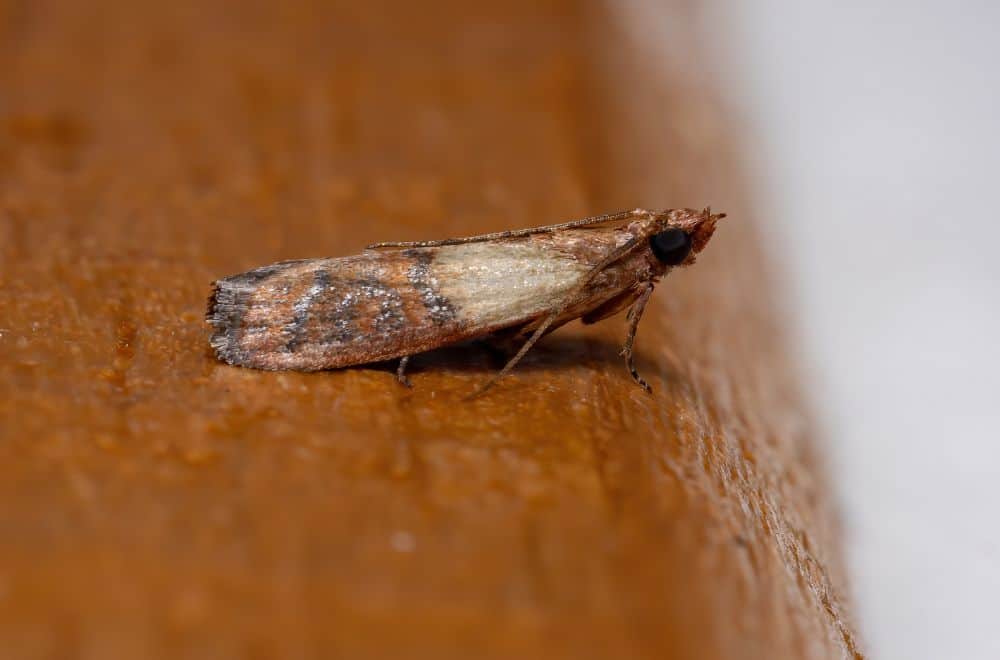
Approximately 0.12 to 0.18 inches (3 – 4.5 mm) long Indian moths and their larvae are among the most common pests that infest pantries. Purple-brown adults with pale yellow lower bodies and greyish-white wings enter your home only to lay their eggs.
An average female moth lays up to 400 eggs in clusters that hatch within 7 to 8 days. Their 0.50 inches (12.7 mm) long larvae are dangerous and feed on flour, cereals, pet food, spices, and seed.
These pests are typically dirty white, but you can also spot brown or green variations, depending on the food they preferably consume. After approximately three weeks, the larvae hatch into adults that will leave your home after laying new eggs.
Other little bugs
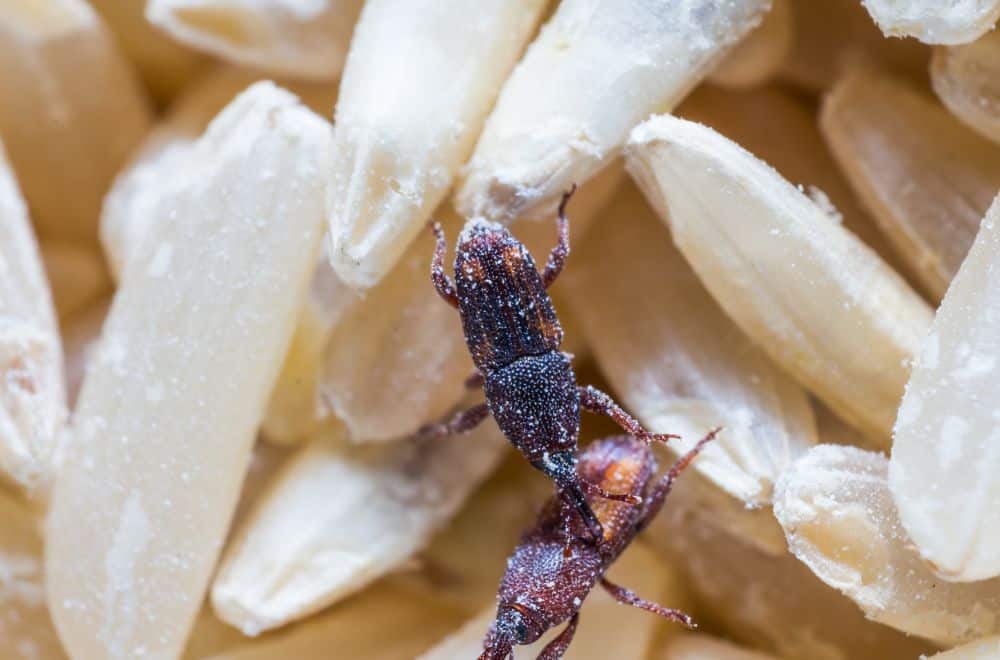
Besides these, the most common little bugs in flour, you can face other pests in your pantry. They typically feed on grains and other products but can consume and infest your flour when it is in their way or when there is no more acceptable food. The most common are:
- Granary weevils
- Maize weevils
- Cigarette beetles
- Drugstore beetles
- Sawtoothed grain beetles
- Warehouse beetles
- Khapra beetles
- Lesser grain beetle
Signs of the Little Flour Bug Presence
The most common signs of flour bug infestation in stored food include:
- Silk ball formation in stored food and flour
- Light brown spots on the flour package surface
- Unpleasant odor
- Fecal pellets presence
- Larvae crawling on flour
- Cocoon formations
When these bugs attack the flour, you can find all or just some of these signs. That primarily depends on the bug species living in your pantry.
Ways to Get Rid of Bugs in the Flour

Once flour bugs inhabit your pantry, they won’t leave it willingly. Fortunately, eliminating these pests is a relatively effortless task, so you can finish the job in a few days if you are patient and persistent.
1. Freeze and throw away contaminated flour
Getting rid of contaminated flour is crucial, but it is recommended to freeze it previously. That way, you will efficiently kill eggs and larvae and prevent future infestation. It will be enough to leave a package with flour in the freezer for about seven days and then throw it away.
2. Clean the pantry
Once you get rid of infested flour packages, it is time to clean your pantry. Start with vacuuming shelves and cleaning the jars and containers you use to store flour and grains.
Then, use natural solutions made of white vinegar, lemon, and distilled water to remove unpleasant odors. Another option is to add soap in warm water and sprinkle shelves before wiping them carefully.
Another option is chemical cleaning agents. Spraying insecticide around wall cracks and holes is the quickest option to eliminate existing bugs and prevent new ones from entering the pantry. That is a way to create a barrier and keep flour safe by killing larvae and eggs.
3. Get proper containers
Storing flour in appropriate containers is the best way to prevent contamination. Buy airtight glass containers and keep flour and grains inside them.
4. Add natural repellants to your kitchen
Natural repellants, like bay leaves and garlic cloves, can be very useful for getting rid of bugs in the flour. It is sometimes enough to arrange them on the shelves in the pantry to keep pests away.
Additionally, applying essential oils is an old and efficient way to keep bugs away from your kitchen and pantry. The best options are black seed, tea tree, eucalyptus, caraway, coriander, and citronella oils.
5. Call professionals
It is necessary to call pest control specialists when a flour bug infestation is too extensive. They will also help you identify what pests you need to deal with when unsure. Always look for a reputable company that can solve the problem safely, efficiently, and quickly.
Flour Bug Infestation Prevention
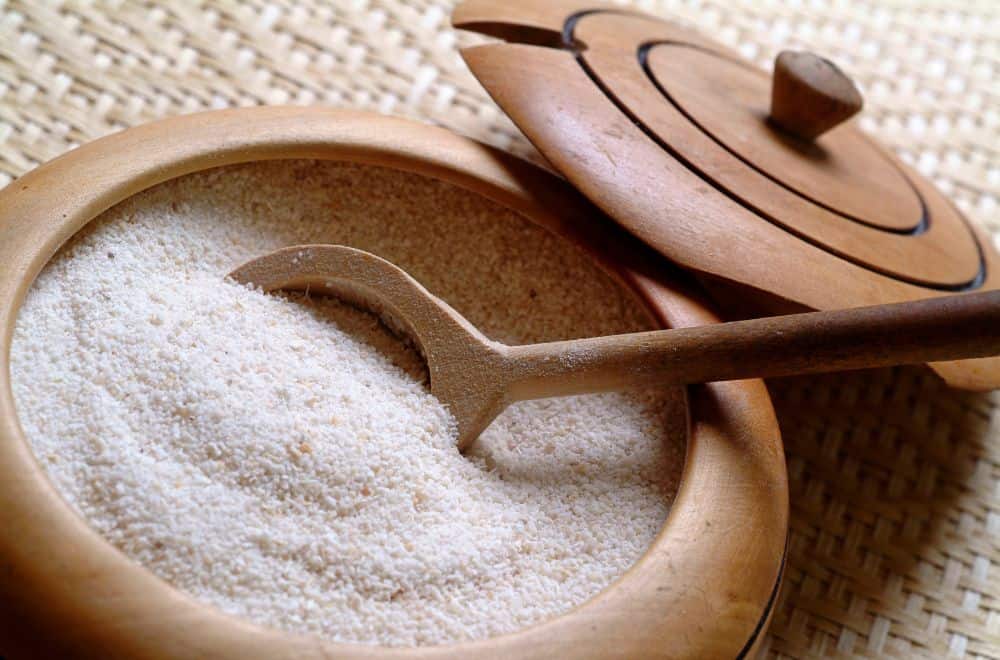
Since little bugs attacking flour and grains are widespread, it can be challenging to prevent an infestation, but it is not impossible. Fortunately, you have a few effective techniques at your disposal. Let’s see.
1. Regularly clean the house
The crucial thing is to clean and vacuum your home regularly, seal wall cracks, and occasionally disinfect the space. The next step is to dust and wash shelves in the kitchen and pantry with detergent and warm water.
Finally, it is recommended to disinfect all surfaces with white vinegar and water solution. Replacing vinegar with lemon juice is possible if you prefer a more pleasant smell.
Be aware that the complete flour bugs and larvae elimination from your pantry takes time, constant maintenance, and patience. Even when you destroy the bugs, they can come back the next season and start the process all over again.
2. Properly store flour
As I have already mentioned, some of these bugs eat paper packages, cardboard boxes, and plastic bags. Therefore, glass containers with airtight seals are the best choice for storing flour and grains.
There is one more excellent method! Put flour in the freezer for 4 to 7 days before storing it. It is an efficient way to kill eggs if there are any.
3. Install window nets and seal cracks
One of the options is to protect windows and seal cracks to prevent bugs from entering your home through those openings.
For instance, you can secure windows and doors by installing dense nets. Then, seal various cracks with a high-quality silicone-based sealant. This material is strong and long-lasting, so bugs can’t bite through it.
4. Use repellents
Natural repellants are an excellent choice for preventing future bug infestations. You can arrange natural ingredients like bay leaves, garlic cloves, and essential oils or some of the many finished products. Excellent barriers against these annoying bugs include:
- Putting bay leaves or garlic cloves on shelves in the kitchen and pantry
- Placing pieces of cotton wool soaked in tea tree oil between containers
Is Infested Flour Safe To Eat?
Unfortunately, you have probably ingested flour beetle eggs and larvae numerous times since flour often comes infected from the mill. Therefore, throwing your ingredients away is not always necessary when noticing bugs in the package.
Tiny bugs in flour neither bite nor transmit infectious diseases, so there is no need to panic. On the other hand, excessive infestation followed by an unpleasant smell and brown flour coloration indicate a change in the quality. Therefore, the best option is to throw the entire amount away.
Summary
Tiny bugs are present in flour more often than you think. Their occurrence in the pantry is unpleasant, and you should find a way to deal with them efficiently. Luckily, you can find numerous natural ways to prevent and eliminate the infestation, but sometimes chemicals and professional help are your only options.
